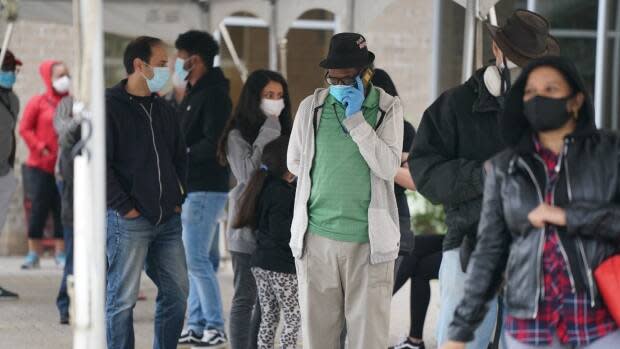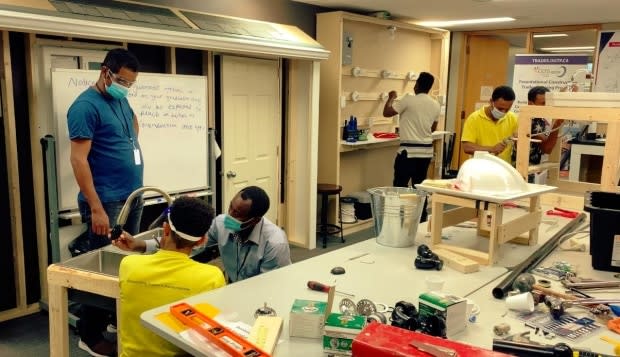Race-based data must be collected to help fight COVID-19, advocates say
It's been suggested by health care professionals and academics that ethnicity is one of the risk factors for COVID-19.
The largest outbreaks in Alberta affected primarily immigrant workers and new Canadians at meat processing facilities in High River and Brooks.
Nearly half of the cases in Calgary can be found east of Deerfoot Trail, in neighbourhoods with larger immigrant populations and higher rates of poverty.
In Ontario, demographic data suggests that minority groups are over-represented in reported cases of the disease. In Alberta, no such data is publicly available, at least not yet.
Human rights advocates, anti-racist groups, researchers and social agencies say the data needs to be collected and shared publicly to ensure those impacted by the disease the most are getting the help they need.
"It could lead to a change in health care," said Linda McKay-Panos, a leading human rights advocate in Alberta.
Alberta Health says the government has instead chosen to focus on risk factors and "case-specific data by age and location" when it comes to sharing information about COVID-19.
"We need to know what's going on in order to more effectively treat it," said McKay-Panos, who is the executive director of the Alberta Civil Liberties Research Centre.

In the United States, the COVID Racial Data Tracker found that Black people are dying 2.5 times the rate of white people.
In Toronto, Black people make up 21 per cent of COVID-19 cases even though they only make up nine per cent of the city's population. White people accounted for 17 per cent of the cases, despite representing 48 per cent of the population. The data also showed lower income earners make up a higher share of the total number of cases in Canada's biggest city.
In Alberta, it's difficult to get a clear picture of exactly who is contracting and spreading the virus. While we do know which areas are being impacted the most, we don't know anything about the people getting the disease, including race, age, gender, disabilitiy or socio-economic status.
Alberta Health has divided the city into 16 local geographic areas with nearly half of the COVID-19 cases being reported east of Deerfoot Trail, in areas identified as upper northeast, lower northeast, east and southeast Calgary.
The numbers show the total cases, total active cases, how many people have recovered and how many have died. Almost half of the cases in Calgary are located in those four areas on the east side.
Beyond those numbers and what we know about those communities, there is no detailed demographic data to help understand why it appears that people in that part of the city seem more likely to test positive for COVID-19 than other areas.
"Until we have that concrete data shared across levels in a standardized format, it lends itself to conjecture," said Jason Devine with the Calgary Anti-Racist Action group.
"If we're talking about how COVID is possibly and most likely unequally impacting certain communities, well that in fact affects us all because a pandemic is beyond all communities and all borders."
In June, 11 of Canada's federal, provincial and territorial human rights commissions, including Alberta's, called on the federal government for a national strategy for the collection of disaggregated health data, which could help identify Canadians who are disproportionately impacted by COVID-19.
The commissions say traditional health data collection is based on a high level of aggregation and reveals limited information about the severity of the impact of the virus on vulnerable and marginalized Canadians.
Those include Black Canadians, Indigenous people, people with disabilities, women, older people living alone or in institutions and "low income communities who have unequal access to health care, child care and are often underemployed."
In response, the prime minister said at the time that more needs to be done to collect more detailed demographic data during the pandemic.
Ontario's Human Rights Commission said that such data, including race, socio-economic status and disability, along with sex and age, is "the foundation of evidence-informed decision-making," and "demographic data collection is a best-practice."
Strong data allows health-care leaders to identify populations at heightened risk of infection or transmission. - Ontario Human Rights Commission
When asked to provide further comment on the letter or on the amount of time that has passed since the request was made to the federal government, the office of the Alberta Human Rights Commission provided a brief response to the CBC.
"This data will help identify inequalities and advance human rights in Canada as we navigate this unprecedented public health crisis," said a spokesperson.
A leading Calgary agency that helps newcomers get settled with language training, employment and housing opportunities echoes the call for better data collection to fully understand who is most at risk of contracting the virus.
"I hope this kind of approach has one purpose and that would be giving our policy-makers and the public information that we really need to pay more attention to our most vulnerable population," said Fariborz Birjandian, the CEO of the Calgary Catholic Immigration Society.
Fear of discrimination, stigma
While there are calls for more information about people impacted by COVID-19, there are also warnings about how the data could lead to further discrimination and stigmatizion of certain groups.
Birjandian says people have to understand the nature of the work taken on by some immigrants and temporary foreign workers already puts them at higher risk, whether it's employment as a cleaner, delivery person, long-term care facility employee or a meat-packing worker.
He says it's also common for newcomers to live in smaller, more crowded conditions and to rely on public transit or carpooling.

"If you just come in and say, 'yes, the immigrants, they are getting more impacted by the disease,' that is not going to help anybody," he said.
McKay-Panos has the same concerns.
"You'd hate to see an employer say, 'well, we're not going to hire you because you have a greater chance of having COVID.'"
"We don't want to see the blowback. In other words, the statistics can't be used negatively. They have to be used in a way to help people so that we can all get through this and address it in a proper way," she said.
Race, ethnicity part of meat packing plant study
A Calgary health researcher is leading a national study that will examine the COVID-19 outbreaks at meat processing facilities in Alberta. The outbreak in the Cargill facility at High River was the site of the largest COVID-19 cluster linked to a single facility in North America.
Dr. Gabriel Fabreau, who studies refugee and immigrant health in Calgary, will lead the study into the outbreaks at Cargill near High River, JBS near Brooks and Harmony Beef in Balzac, north of Calgary.
The Canadian Institutes for Health Research is funding the $365,000 study, which will look into why the outbreaks mostly affected new immigrants, refugees and temporary foreign workers and their communities.
"We suspect that newcomer communities were primarily affected; that needs to be quantified," he said.
Fabreau says his research will examine what he calls the 'transmission chain," and why the virus spread so quickly.
"Where did it start? Who got it next? Where did that go next? How did that interact with the rest of the clusters of outbreaks in our community?"

Fabreau, who is an assistant professor at the Cumming School of Medicine at the University of Calgary, says other factors will also be examined, including housing, transportation, language barriers and access to public health-care resources.
Fabreau says more detailed demographic data collected during his research — and throughout the pandemic — could uncover inequities in health care. But he says it needs to go beyond race and ethnicity.
"We need to collect the social determinants of health more broadly. So income and education, housing, socioeconomic status," he said.
"Those sorts of data would really help us first understand how health is being distributed in our country, and then to see how those factors are interacting to affect people's health."
"By not routinely collecting them, it makes it very difficult," said Fabreau.
Data collection, sharing 'important'
Alberta Health says there may be more information related to race-based reporting coming in the days and weeks ahead.
A spokesperson for the department says they are looking at ways to "effectively report" demographic data on race, ethnicity and socio-economic status of patients.
"We hope to have more information to share soon," said Tom McMillan.
For more stories about the experiences of Black Canadians — from anti-Black racism to success stories within the Black community — check out Being Black in Canada, a CBC project Black Canadians can be proud of. You can read more stories here.

Bryan Labby is an enterprise reporter with CBC Calgary. If you have a good story idea or tip, you can reach him at bryan.labby@cbc.ca or on Twitter at @CBCBryan.


